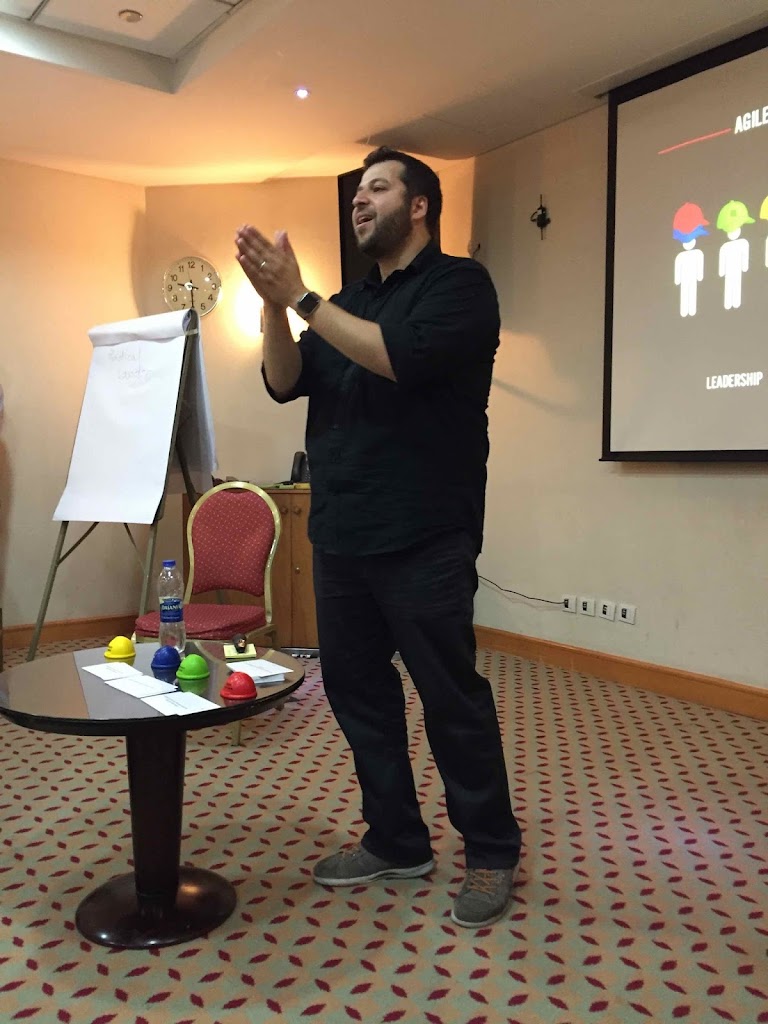
Session: Agile Project Manager, Product Owner and ScrumMaster are all broken – The Next Evolution of Agile Leadership Roles
At: Holiday-inn Hotel … City Stars, Cairo, Egypt
Date: 8 Sept 2016,
——–
——–
There was a QA session followed by a session by Ahmed Sidky. My comments here are
related to Sidky session.
related to Sidky session.
In my opinion, he was presenting his experience in managing
ownership and accountability in his Riot Games company.
ownership and accountability in his Riot Games company.
First, he showed that, after joining Riot, he found the
traditional Agile roles are confusing and makes it difficult to decide which
one is really accountable for team results. That situation pushed him to experiment
and come up with a different model.
traditional Agile roles are confusing and makes it difficult to decide which
one is really accountable for team results. That situation pushed him to experiment
and come up with a different model.
Sidky broke up responsibilities into 35 distinct responsibilities.
He was presenting them in the form of plastic cards, something similar to Planning
Poker cards but double its size.
He was presenting them in the form of plastic cards, something similar to Planning
Poker cards but double its size.
At Riot Games, they created 4 leadership roles as following:
- Team
Captain: This is the
head of the other three leads. He is accountable about the project. He is
the only accountable person in the four leadership roles. Later on, I will
explain what is meant by being accountable. - Delivery
Lead: Responsible
about delivery deadlines.
- Product
Lead: Responsible
about the product scope, something like Product Owner, I think. - Craft
Lead: Like Test
Lead, Developers Lead and so on. He is responsible about the craft quality
and standards of his/her team’s work.
Sidky gave color for each leadership role, for example red color is
assigned to the Team Captain. He showed us physical hats with different colors.
The only problem is that; the size of hats is a little bit small to be wore by
humans.
assigned to the Team Captain. He showed us physical hats with different colors.
The only problem is that; the size of hats is a little bit small to be wore by
humans.
From the 35 responsibilities, there are 10 that are hard coded to
each role and cannot be changed.
each role and cannot be changed.
First, the project team conduct a workshop with team members. They
list the other 25 role cards and they collaborate to assign each of these
responsibilities to these hats/roles.
list the other 25 role cards and they collaborate to assign each of these
responsibilities to these hats/roles.
Then, the team self-organize to assign a team member to each role/hat.
There may be some additional conversations and negotiation until the team agree
on the result. The result will be that, all 35 responsibilities are distributed
on the four roles and a team member is assigned to each role/hat. Each team member
can have one or more hats, or none at all of course.
There may be some additional conversations and negotiation until the team agree
on the result. The result will be that, all 35 responsibilities are distributed
on the four roles and a team member is assigned to each role/hat. Each team member
can have one or more hats, or none at all of course.
Regarding accountability, Sidky described three steps for poor performance
evaluation. First Step is to conduct a meeting, understand the problem, and
what to do about it now and in the future. There is no blame culture, any one
mentioned in conversation is invited immediately.
evaluation. First Step is to conduct a meeting, understand the problem, and
what to do about it now and in the future. There is no blame culture, any one
mentioned in conversation is invited immediately.
Second Poor Performance case: Just like the first one. I expect
the conversation will be more difficult.
the conversation will be more difficult.
Third poor performance case: Here is where management will take
action.
action.
He mentioned that, we cannot overlook that, there are poor members
and good members. In some cases, you have to fire poor performing members.
and good members. In some cases, you have to fire poor performing members.
Note: The above description is a representation
of my understanding to what Sidky proposed. It may be incomplete or inaccurate.
Your feedback is welcomed.
of my understanding to what Sidky proposed. It may be incomplete or inaccurate.
Your feedback is welcomed.
My Personal Notes:
- I find it is OK to
design your role in your organization. Feel free to break the famous Scrum
Roles SM/PO if it makes sense. According to Agile
Manifesto, roles are not included in Agile Values or Principles. It was described
in Scrum and many people find it useful. - As Sidky said that,
this is RI phase of
inventing things. If you are an Agile beginner, be careful and follow some well-known
recipes, such as Scrum or Kanban. - I find it very
self-organizing and matches Agile spirit to let the team collaborate on
responsibilities and role assignment.
It was a fun event, Sidky enjoys
a sense of humor. Here are some pictures from the event.
a sense of humor. Here are some pictures from the event.
From ahm507.blogspot.com



